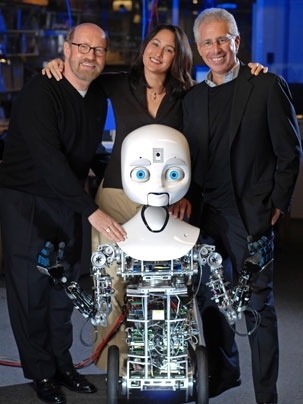The MIT Media Laboratory today announced the creation of the Center for Future Storytelling, made possible through a seven-year, $25 million commitment from Plymouth Rock Studios, a major motion picture and television studio that is expected to open in 2010 in Plymouth, Mass.
With the establishment of the center, whose research program begins immediately, the Media Lab and Plymouth Rock Studios will collaborate to revolutionize how we tell our stories, from major motion pictures to peer-to-peer multimedia sharing. By applying leading-edge technologies to make stories more interactive, improvisational and social, researchers will seek to transform audiences into active participants in the storytelling process, bridging the real and virtual worlds, and allowing everyone to make their own unique stories with user-generated content on the Web. Center research will also focus on ways to revolutionize imaging and display technologies, including developing next-generation cameras and programmable studios, making movie production more versatile and economic.
"Storytelling is at the very root of what makes us uniquely human," said Frank Moss, Media Lab director and holder of the Jerome Wiesner Professorship of Media Arts and Sciences. "It is how we share our experiences, learn from our past, and imagine our future. But how we tell our stories depends on another uniquely human characteristic -- our ability to invent and harness technology. From the printing press to the Internet, technology has given people new ways to tell their stories, allowing them to reach new levels of creativity and personal fulfillment. The shared vision of the MIT Media Lab and Plymouth Rock Studios allows us to take the next quantum leap in storytelling, empowering ordinary people to connect in extraordinary ways."
"This is a great opportunity to draw on the exceptional intelligence and innovation for which the Media Lab is known worldwide," said David Kirkpatrick, chairman and executive managing officer of Plymouth Rock Studios and former president of Paramount's Motion Picture Group. "Plymouth Rock Studios was conceived as a source for innovation and as a proving ground for new storytelling technologies. This collaboration will transform the movie-making model, and erase some of the technology barriers that constrain the narrative form."
The Center for Future Storytelling will be co-directed by three Media Lab principal investigators: V. Michael Bove Jr., an expert in object-based media and interactive television; LG Associate Professor Cynthia Breazeal, a leader in the field of personal robots and human-robot interaction; and Associate Professor Ramesh Raskar, a pioneer in the development of new imaging, display and performance-capture technologies.
Research will range from on-set motion capture to accurately and unobtrusively merge human performers and digital character models; to next-generation synthetic performer technologies, such as richly interactive, highly expressive robotic or animated characters; to cameras that will spawn entirely new visual art forms; to morphable movie studios, where one studio can be turned into many through advanced visual imaging techniques; to holographic TV. It will draw on technologies pioneered at the Media Lab, such as digital systems that understand people at an emotional level, or cameras capable of capturing the intent of the storyteller.
"We see this as an experiment in collaborative education, but also as a bold adventure in business innovation that could have significance well beyond the motion picture industry," Moss said.
A version of this article appeared in MIT Tech Talk on November 19, 2008 (download PDF).






